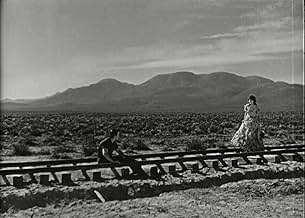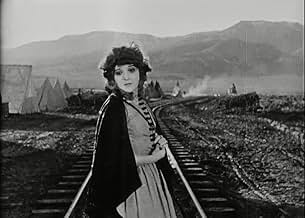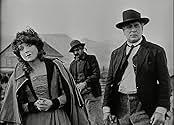Après avoir assisté, enfant, au meurtre de son père par un renégat, Brandon, devenu adulte, aide à réaliser le rêve de son père, à savoir la construction d'un chemin de fer transcontinental.Après avoir assisté, enfant, au meurtre de son père par un renégat, Brandon, devenu adulte, aide à réaliser le rêve de son père, à savoir la construction d'un chemin de fer transcontinental.Après avoir assisté, enfant, au meurtre de son père par un renégat, Brandon, devenu adulte, aide à réaliser le rêve de son père, à savoir la construction d'un chemin de fer transcontinental.
- Réalisation
- Scénario
- Casting principal
- Récompenses
- 2 victoires au total
- Cpl. Casey
- (as J. Farrell Macdonald)
- Pvt. Schultz
- (as James Welch)
- …
- Buffalo Bill Cody
- (as George Wagner)
- Judge Haller
- (as James Marcus)
- Cheyenne Chief
- (non crédité)
- Indian
- (non crédité)
- Worker
- (non crédité)
- Worker
- (non crédité)
- Minor Role
- (non crédité)
- Rail Worker
- (non crédité)
Avis à la une
The story of The Iron Horse begins here in Springfield, Illinois where the children of Will Walling a contractor and surveyor James Gordon are playing while their fathers are meeting with none other than Abraham Lincoln at that time just a state legislator. Both would like to see a transcontinental railroad and Gordon is going to make good on it by going west and surveying the best route through the Rocky Mountains. But out west the surveyor is killed by hostile Indians led by a white man with only two fingers on his right hand. But the boy hides and is missed and grows up to be frontiersman George O'Brien.
Twenty years later in the midst of the great Civil War, President Abraham Lincoln signs the legislation authorizing the building of such a railroad though the real work doesn't start until the war is over. By that time Will Walling is working on building the Union Pacific and his daughter has grown up to be Madge Bellamy. She's engaged to Cyril Chadwick another surveyor, but Chadwick has some mixed loyalties.
Those of you who saw the epic DeMille production Union Pacific will recognize from this point some of the same plot situations. No doubt Cecil B. DeMille borrowed quite a bit from The Iron Horse, but I will say DeMille wrecked his train during the Indian attack and it was a beauty. But Ford with all the extras involved could say that his was to use the cliché, a cast of thousands.
The real evil villain here just as Brian Donlevy was in Union Pacific is Fred Kohler. He's behind a lot of the scheming as he's a large landowner where the Cheyenne Indians seem to function as a personal army. Now that was a bit much to swallow. As was the fact that when the grown up George O'Brien first makes his appearance he is identified as a Pony Express rider. Everyone knows that the Pony Express was a year long phenomenon that the Civil War closed down and the telegraph and railroad put out of business permanently. But Ford was also interested in the poetry of the west rather than the facts.
Still the action of The Iron Horse holds up remarkably well today and the careers of both John Ford and George O'Brien were made with this film.
The Western itself of course went through many developments in theme, and can be grouped into different phases. The Iron Horse, along with Covered Wagon, Three Bad Men (1926) and The Big Trail (1930) belongs squarely to the "pioneer" Westerns which dominate this era. In these pictures the west would typically be an unclaimed wilderness, and the heroes were those who explored, settled and developed it. By now the genuine old west was fading from living memory, and so now we had the first generation for whom it could be a romanticised piece of history. Plus of course there is the fact that the wagon trails, railroads and cattle drives of the pioneer Western were ideal for the aforementioned fashion for epic pictures.
Today of course The Iron Horse is best remembered for its director a young John Ford. Even back then Ford had a close association with the Western, although to some extent his style is still in development here. His shot composition relies heavily on very distinctive framing devices such as tree branches or posts, and sometimes the shots look a little cluttered. Also, his approach to the romantic love scenes is entirely conventional with close-ups, rhyming angles and sparse backgrounds so as to focus on the actors. The older (more cynical?) John Ford tended to shoot these moments rather flatly, the camera hanging back, and even throwing in distracting background business.
On the other hand, and perhaps in ways that matter more, this is very much the same John Ford of Stagecoach, Fort Apache and so forth. In particular is his vision of the west. Right from the opening scenes he contrasts the smallness of the homestead with the romantic allure of the wilderness framing the actors tightly in the opening shots, and then cutting to point-of-view shots of the trail. He always captures the vastness of the outdoors, and yet without ever dwarfing the people in it. Particularly impressive (and this is perhaps where Ford's greatest strength lay) is his ability to combine different storytelling elements in a single shot for example at one point we see a mother mourn her son at his grave in the foreground, while a heavily loaded train passes through in the background.
Another typically Fordian element is the precedence he gives to the comic relief characters. On location they were largely working without a script, so Ford could spin their scenes out as long as he wanted. As with many of his later pictures, charming though it is, the comedy business threatens to unbalance the real story. We can also see in "Drill ye terriers" a forerunner to the group singsong that is a staple of even the earliest John Ford talkies.
A nod to the actors is also due. This was George O'Brien's first lead role and he doesn't do badly, considering he got the part mainly for being a good-looking newcomer who could ride a horse. He doesn't emote too convincingly, but he moves well which is the most important thing for a picture like this. The other standout is J. Farrell MacDonald, who played the kind of roles for Ford in the silent era that would later be filled by Victor McLaglan in the talkies basically a comical Irish drunk. But like McLaglan he hid real dramatic talent under the act, and he emerges as the most genuine player in this piece.
Ford's confidence and passion for the genre make the Iron Horse a classic, but it's worth remembering that The Iron Horse is also a triumph of post-production. Cast and crew had gone on location without a complete shooting script and large chunks of it are more or less improvised. As well as directing Ford took one of his earliest credits of producer and, would thus have been able to continue supervising the product after shooting was over. It's hard to imagine what any other producer or editor would have made of the footage he brought back from location. It's unlikely they would have kept so much of the comic diversions and "oirishness", and it's perhaps with The Iron Horse that we have - for better or for worse - the earliest example of an unbridled John Ford.
It's a story that characteristically combines the grand with the intimate, through a celebration of the coming of progress. The Iron Horse's narrative covers such issues as the Civil War, Lincoln's presidency, the Indian wars, Buffalo Bill, Wild Bill Hickok, ethnic relationships, cattle trailing and railway history in a span of little over two hours - all with an absence of narrative strain still impressive today. Ford's skill in marshalling many disparate elements into one large canvas, successfully orchestrating history (proudly announced here as 'accurate and faithful in every particular') is one example why he was such an exemplary Western director.
George O'Brien plays Davy Brandon, whose father dreams of rails eventually crossing the continent. After setting out for the west, Brandon senior is killed by the evil Two Fingers (Fred Kohler). Years later Davy sets to work for Union Pacific, scouting for a short cut through Cheyenne territory that will ensure the success of the transcontinental link up. Aiming to prevent this are the dastardly forces of corrupt surveyor Jesson (Peter Chadwick) and half-breed Baumann (Kohler). Meanwhile, Davy discovers his childhood sweetheart Miriam (Madge Bellamy) is engaged to the disreputable Jesson. The rest, as they say, is history.
Throughout Ford's career he was wont to use symbols to indicate the coming of progress in the West. In My Darling Clementine (1946) it was the social dance at the unfinished church. In Liberty Valance (1964) the desert flowers on Tom Doniphon's (Wayne's) coffin. The Iron Horse is dedicated to George Stevenson and, not unexpectedly, here it is the railway itself that represents the growth of civilisation. Its ultimate success as an enterprise is less that of a profitable commercial venture than of beneficial ideal, as visualised by President Lincoln.
Amidst the idealism of railway expansion, Ford includes the broad comedy common to many of his films - the Irish and Italian labourers continuing a friendly rivalry. Their work songs, spelt out in caption cards while they construct the track, punctuate the action, creating convenient breathing spaces between more dramatic scenes. The 'three musketeers' - as Slattery (Francis Powers) Casey (Farrell Macdonald) and Schultz (Jim Welch) are called - have their own amusing scenes based around some frontier dentistry. But essentially they function as a kind of comic chorus, their earthy, ethnic interjections keeping the film's idealism down to earth. There's an element of this too in Judge Haller (James Marcus), a Roy Bean character, whose dispensation of frontier justice is as arbitrary as it is often inspired.
Least convincing to the modern viewer is the character of Miriam, whose simpering virginity comes closest to the two-dimensional women found often in the world of D.W. Griffith's melodramas. Her condemnation of the clean living Davy's visit to the saloon, immediately after being with her (where, ironically, he has gone to patch things up with Jesson) seems almost wilfully annoying; ludicrous even, given the rough environment in which she finds herself. But that her heart belongs to the muscular scout is never in doubt, a fact made clear by their rapport in the opening scenes set in their childhood. In addition, once she has gained womanhood, her pending relationship with Jesson is condemned by implication as President Lincoln looks askance at their match. The same dramatic shorthand is employed through the palpable tension when Davy and Baumann first meet, an impending confrontation telegraphed as sharply as any message sent by mechanical means.
There is also a intense psychological antipathy between Davy and Jesson, notably in the standout barroom scene. In these moments O'Brien plays well, almost making one forget Ford's great films with Wayne to come. But, by necessity, this is principally a film of the great outdoors where Ford excels in portraying man battling against external obstacles, rather than facing internal stress. In his Stagecoach (1938), which was to later revitalise the genre, it would be a different story, one of comparative intimacy. Here, the heroes and villains who react together along the railroad work out their differences in the open air with grand gestures, fisticuffs and work songs, rather than anguished conversation. And it is these epic scenes that remain in the mind when the film is done. The attack of the Indians on the supply train, their furious shadows thrown against the sides of the carriages; the snow swept work camps; the many panoramas of frontier life; Davy and Bauman's final conflict in the sleeper 'house'; the final meeting at Promontory Point for the 'wedding of the rails', and so on.
Such visual grandness does not preclude economy however. One only has to think of hurriedly arranged burial of 'the old soak' and the marriage held at North Platte, or the establishing scenes at the beginning of the film, to see how Ford was fully in command of his material, switching scale and focus with ease.
With the joining of the two railroads and the closing of the bond between Miriam and Davy, there is a natural conclusion to both the human, and the mechanical elements of the story - Davy actually waits until the final spike has been driven home before committing himself to her side. Thematically, Fritz Lang was to acknowledge a debt to Ford's classic in his Western Union (1938), which has a related story, but his film is the slighter of the two and less innocent. Ford's epic remains the definitive telling of these particular events and its authenticity can still be recommended today.
Le saviez-vous
- AnecdotesThe kitchen staff for the film was made up largely of Chinese cooks. Some of them had been workers on the transcontinental railroad in 1869, the same construction project that forms the basis of this film.
- GaffesThe locomotives and rolling stock use knuckle-type couplers, which did not begin wide use until the 1890s. In the 1860s-era setting of this movie, the couplers in use would have been link-and-pin. This anachronism is understandable as the safety issue would have prohibited the use of the era-appropriate link-and-pin couplers.
- Citations
Thomas Marsh: [after Brandon, Sr. leaves to go west to pursue building a transcontinental railroad] Poor dreamer - he's chasing a rainbow!
Lincoln: Yes, Tom - and some day men like you will be laying rails along that rainbow.
- Versions alternativesThe DVD release of this film contains two different edits, one for the American market and one for Europe. The American release is 16 minutes longer than the European cut. The American cut is dedicated to the memory of Abraham Lincoln while the European release is dedicated to the memory of George Stephenson. In the American release Fred Kohler's character is named Deroux while in the European cut his character is named Bauman.
- ConnexionsEdited into The Story of Our Flag (1939)
- Bandes originalesBlow the Man Down
(uncredited)
Traditional 19th Century Sea Chanty (1860s)
[Integrated into restoration score into divorce and going back to work scenes]
Meilleurs choix
- How long is The Iron Horse?Alimenté par Alexa
Détails
Box-office
- Budget
- 450 000 $US (estimé)
- Durée
- 2h 30min(150 min)
- Mixage
- Rapport de forme
- 1.33 : 1


































